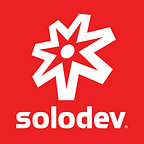Pull Your Website Up By its Own Bootstraps
Easy Bootstrap Tutorials to Elevate Your Website’s Look and Functionality
Since it came online in 2011, Bootstrap has managed to become a front-end developer’s best friend. The open-source library contains a plethora of CSS and HTML-based design templates, reducing headaches and streamlining development. It allows devs a quick way to prototype ideas or build an app with Sass variables and a responsive grid system.
It was originally crafted by designers and developers at Twitter, but it’s quickly become one of the biggest frameworks for front-end devs in the world.
And (just in case it wasn’t clear) we’re big fans of Bootstrap at Solodev.
Yes, even award-winning content management software companies love keeping things simple.
“Bootstrap just makes standardizing you code, user experiences, modules, and end functionality as easy as reasonably possible. The library is a fundamental component to our development and we value its intuitive structure and expandable nature.” — Scott Madara, Director of Web Development at Solodev
Here’s a list of our favorite Bootstrap tutorials for spicing up any website:
Create a Blog with Bootstrap
Running a company blog can do wonders for a brand. It establishes your company’s insights into your particular industry. Blog posts offer help to your target market — keeping them coming back to learn more information. Plus, blogs can boost overall website traffic through savvy inbound linking.
Basically, if you’re not blogging, you need to.
This tutorial walks you through how to set up a must-have for any business.
Creating a Team Page with Bootstrap
Surprise — there are actual humans running your company! Studies have shown that among any industry and in businesses of various sizes, putting faces with names behind a business boosts both brand trust and brand recognition.
Showcase your team with this simple tutorial (and prove to everyone that your marketers aren’t actually androids).
How to Use Bootstrap Accordions to Organize FAQ Pages
FAQs (Frequently Asked Questions) are some of the most helpful and frequently visited pages on a website. Here’s how to consolidate and style them in a way that makes sense to users without overwhelming them with copy.
Using Lazy Load Images within a Bootstrap Grid
This Bootstrap tutorial combats one of the biggest culprits of slow websites. Using Bootstrap grids, you can make repeatable elements that load responsively and can showcase a variety of images.
Adding a Filter to your Search Input using Bootstrap
Search engines might be a great way to drive people to your website, but it won’t necessarily point them exactly where they need to go on your website.
This tutorial leaves your website with an additional category filter to an initial search input in order to give your visitors the best website results.
Using Bootstrap Tabs to Showcase Portfolio Elements
Your successes with older clients will attract new clients, especially if you have your client work showcased in a visually appealing layout. This Bootstrap shows you how to integrate an interactive client portfolio.
Design a Client Showcase with Bootstrap
Need another way to showcase your clients? This tutorial offers up a simple layout to show off things like logos or other client elements.
*******************************************************************
Want to learn more about the basics of Bootstrap — including its latest iteration of Bootstrap 4? FreeCodeCamp offers a fantastic in-depth walk through of the biggest changes.
— — — — — — — — — — — — — — — — — — — — — — — — — — — — — — —
Like what you read? Clap 5 times! 10 times! Go all out and do a full 50 claps! And for more from Solodev — a premier content management system — subscribe to our newsletter or check out our web design blog!
